Years 3 & 4: Multiplication and Division
This list consists of visual resources, activities and games designed to support the new curriculum programme of study in Years 3 and 4. Containing tips on using the resources and suggestions for further use, it covers:
Year 3: Recall and use multiplication and division facts for the 3, 4 and 8 multiplication tables, write and calculate mathematical statements for multiplication and division that they know, including for two-digit numbers times one-digit numbers, using mental and progressing to formal written methods, solve problems, including missing number problems, involving multiplication and division, including positive integer scaling problems and correspondence problems in which n objects are connected to m objects.
Year 4: Recall multiplication and division facts for multiplication tables up to 12 × 12, use place value, known and derived facts to multiply and divide mentally, including: multiplying by 0 and 1, dividing by 1, multiplying together three numbers, recognise and use factor pairs and commutativity in mental calculations, multiply two-digit and three-digit numbers by a one-digit number using formal written layout, solve problems involving multiplying and adding, including using the distributive law to multiply two-digit numbers by one-digit, integer scaling problems and harder correspondence problems such as n objects are connected to m objects.
Visit the primary mathematics webpage to access all lists.
- ALL
- Teacher guidance
- Video
- Game
- Image
- Activity sheet
- External link
Teacher guidance
Multiplication - EAL
Although the activities in this resource have been created for pupils for whom English is an additional language, the activities are suitable for all pupils studying multiplication as they help to establish the exact meaning and use of the vocabulary used around multiplication, such as 'times' and 'lots of'. Sets of flashcards contain useful visual representations of this vocabulary which enables pupils to hear and rehearse the language. A Connect 4 game gives pupils the opportunity to practise their language and mathematical skills.
Video
Grid Multiplication as an Interim Step
This short video demonstrates how place value counters may help children to represent a calculation, whilst using the grid method of multiplication. Children may be able to perform calculations independently using the grid method and the counters to support them. This could be a whole class activity or used to support small groups.
Just Division
This video demonstrates an interesting way of demonstrating division using plastic cups and will help visual, audio and kinaesthetic learners of maths. Children put cups into groups of, for example, 6 then see how many groups they have. The cups show children a concrete representation of division which they are then able to link to the abstract calculation. Children in this clip are moved on to dividing much larger numbers. It is also a great way of increasing confidence in children needing support in learning division.
Game
Multi-Race Game
This game allows children to practice multiplication problems. Children move along a track landing on different numbers, mainly from the 6, 7, 8 and 9 times tables. To move they must say the pair of numbers (factors) which will multiply together to give a nearby product on the board. It contains two boards and teachers' notes with instructions of how to play the different games (there are ten different ways to play). There is also a blank board so teachers can easily adapt the game to suit any specific needs. A great one to laminate and have in your maths games collection!
Image
Models and images materials
This set of images and models, from the National Strategies, give examples of key pictorial representations and abstract which can enhance the teaching of mental calculation strategies through Years One to Three. In addition, the materials offer a list of potential difficulties and examples to illustrate progression through to Years Four, Five and Six.
Activity sheet
Multiplication
The times tables booklets included in this resource are extremely useful in allowing children to learn and practise their times tables. A great idea for homework or in class.
It also looks at Gelosia and Napiers bones as methods of multiplication.
External link
Arrays, Multiplication and Division
Arrays may help in the learning of multiplication and division in many ways, for example, in building multiplication facts in a meaningful way. Showing the progressive addition of another column of 4 objects will allow children to build the four times table and see where it comes from. This visual image will help children in learning and using the times tables. Arrays may also be used when learning more formal methods such as the grid method, or compensation.
Maths Chase
Have fun practising times tables in this fun game. Choose a character to move across a bridge as a monster gives chase. The ability to change the level, will test the speed of times tables knowledge to the limit!






